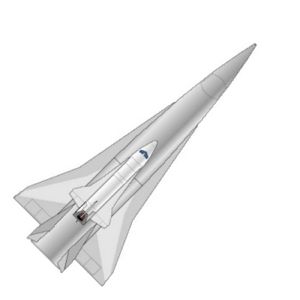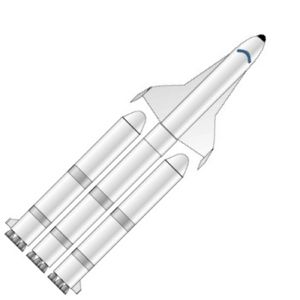
Home - Search - Browse - Alphabetic Index: 0- 1- 2- 3- 4- 5- 6- 7- 8- 9
A- B- C- D- E- F- G- H- I- J- K- L- M- N- O- P- Q- R- S- T- U- V- W- X- Y- Z
Chang Cheng 1
 H-2 HTOHL Credit: © Mark Wade |
Status: Design 1988. Payload: 6,000 kg (13,200 lb). Thrust: 2,400.00 kN (539,500 lbf). Gross mass: 330,000 kg (720,000 lb). Height: 85.00 m (278.00 ft). Diameter: 12.00 m (39.00 ft). Apogee: 500 km (310 mi).
Each of the modular booster stages designed by Shanghai were 4.5 m in diameter and 29 m long, with a mass of 330 metric tons. The shuttle had a wingspan of 17 m, a length of 24 m, and a 4.5 m fuselage diameter. It was essentially a 2/3 scale version of the American shuttle, with half the wing area and launch mass. It is probable that the spacecraft used the same propulsion systems as the upper stage of the Shanghai upper stage expendable system. This would mean the upper stage was around 57 metric tons in mass, with just over half of that being propellant, yielding a net payload to orbit of 6 metric tons plus a crew of two.
China began preliminary work on advanced manned spaceflight in July 1985. The decision came against a background of vigorous international space activity. The United States had its Strategic Defense Initiative and Space Station Freedom. The Soviet Union had its Buran shuttle system, Mir and Mir-2 space stations, and its own star wars program. Europe was developing the Hermes manned spaceplane, and Japan the Hope winged spacecraft. Even India and China were taking on ambitious space projects. It seemed China would have to take action to remain a world power.
Ren Xin Min, the leading Chinese rocketry expert of the time, believed that China should make a space station its national goal. This would develop all aspects of space technology, including modern launch vehicle capabilities. In early spring 1986, members of a standing committee of the Chinese Academy of Sciences (Wang Da Hang, Wang Ganchang, Yang Jiachi, Chen Fangyun) proposed a family of seven Project 863 plans to accelerate Chinese technical development. These numbered plans covered biology, astronautics, information technology, military technology, automation, energy, and materials science. Astronautics plan 863-2 included section 863-204 space transportation system, which would service the 863-205 space station. It was estimated that two years would be needed for concept studies.
An expert group was established for the 863-204 shuttle, and issued a tender call to Chinese industry within two months of starting work. Two months later 11 alternate proposals were delivered, of which six were selected for feasibility studies. These were delivered in June 1988. The six proposals, ranked in order of technical sophistication, were:
- H-2 horizontal takeoff/horizontal landing two-stage reusable space shuttle, proposed by Institute 601 of the Air Ministry. The first stage would used air breathing engines to accelerate the rocket-powered second stage to release velocity. This ambitious design would leapfrog China ahead of other spacefaring nations, but would be available no earlier than 2015.
- V-2 vertical takeoff/horizontal landing two-stage reusable space shuttle, proposed by Beijing Department 11 of the Air Ministry. The first stage would use liquid oxygen/kerosene engines, while the second would use liquid oxygen/hydrogen engines. Both stages would be winged, and first flight would be no earlier than 2015.
- Chang Cheng 1 (Great Wall 1) vertical takeoff/horizontal landing two-stage space shuttle, a compromise design created jointly by Shanghai Astronautics Bureau 805 (now the Shanghai Academy of Spaceflight Technology) and Institute 604 of the Air Ministry. An expendable booster, based on existing technology, would boost the winged second stage shuttle to a high altitude. The engines of the second stage would take it to orbit. This approach would allow a first flight to be made in 2008.
- Tian Jiao 1 (Pre-eminent in Space 1) vertical takeoff/horizontal landing spaceplane, proposed by the First Academy (now the China Academy of Launch Technology). It duplicated the aerodynamic shape of the American shuttle, but was a fraction of the size. Unlike the shuttle, the engines would not be recovered - the spaceplane would be launched by an existing expendable booster. Pursuing this as a more modest first objective would allow China to take an incremental approach to eventually achieving a reusable shuttle. Conceived as being able to fly in both unmanned and manned modes, Tian Jiao 1 could be available by 2003.
- Hermes spaceplane. Institute 611 of the Ministry of Air was involved in collaborative projects with France at the time. They judged the existing technical development of China and France to be roughly equivalent. This meant it would be possible for China to license-build the European Hermes manned spaceplane for its own use. This would be the quickest and most efficient way for China to obtain the latest manned spaceflight technology, with a first flight in the 1990's.
- Department 508 of the Fifth Academy (now the Chinese Academy of Space Technology) proposed a manned space capsule, recovered by parachute, similar to the Soviet Soyuz spacecraft. Department 508 argued that the Chinese industrial and technical base was not realistically up to developing winged reusable spacecraft, and that this would take a very long time and would not be flying until well into the 21st Century. A capsule should be developed in any case as a lifeboat for the space station, and would provide a Chinese manned space capability by the year 2000 - and until a winged spacecraft was available.
Seventeen experts met in Harbin during 20-31 July, 1988, to make final assessments and recommend a course of action. It finally concluded that development of a winged reusable space shuttle system was acceptable as a national long-term goal to guide technology development But China did not have aerodynamic or rocket technology to develop a hypersonic aircraft with reusable rocket engines. The two designs that were considered technically achievable ranked very close in the expert's rating system - the Tian Jao 1 with a score of 83.69, and the Department 508 manned space capsule with a score of 84.00. However no decision could be made as to one or the other at the conference, and the debate raged further.
The final 863-204 Expert Commission report in July 1989 advocated building the manned capsule, with a first flight date of 2000. This would satisfy the leadership's desire for an early Chinese manned space capability, and establish the essential earthly infrastructure and spacecraft subsystems technology for more advanced systems. However in parallel development of technology for a two-stage-two-orbit horizontal takeoff and landing reusable space shuttle would be pursued, with a first flight date of 2015.
The report failed to impress the government. Chinese leader Deng Xiaoping rejected both plans, saying that neither could be flying in his lifetime. The Chinese space establishment went back to the drawing board. However within three years the plan for a manned capsule would be resurrected as Project 921, which would make its first manned flight in 2003 as the Shenzhou spacecraft.
A rearguard action was fought to try to include new booster development. In October 1993 the Shanghai Astronautics Bureau proposed development of six large carrier rockets and eight new spacecraft, including a manned one, for inclusion in the Eight and Ninth Five Year Economic Plans. But this was not approved. Shanghai's program for development of a new generation of liquid oxygen / kerosene rockets was shelved, and those resources were instead put into the development of large solid motors for military use. This marked the abandonment of the last design element of the Chang Cheng 1 design concept.
LEO Payload: 6,000 kg (13,200 lb) to a 500 km orbit at 52.00 degrees.
Stage Data - Chang Cheng 1
- Stage 0. 2 x Project 921-1. Gross Mass: 306,000 kg (674,000 lb). Empty Mass: 20,000 kg (44,000 lb). Thrust (vac): 5,406.141 kN (1,215,349 lbf). Isp: 330 sec. Burn time: 170 sec. Isp(sl): 293 sec. Diameter: 4.50 m (14.70 ft). Span: 7.50 m (24.60 ft). Length: 29.00 m (95.00 ft). Propellants: Lox/Kerosene. No Engines: 4. Status: Study 1992. Comments: Engine chamber pressure 13 to 15 Mpa.
- Stage 1. 1 x Project 921-1. Gross Mass: 306,000 kg (674,000 lb). Empty Mass: 20,000 kg (44,000 lb). Thrust (vac): 5,406.141 kN (1,215,349 lbf). Isp: 330 sec. Burn time: 170 sec. Isp(sl): 293 sec. Diameter: 4.50 m (14.70 ft). Span: 7.50 m (24.60 ft). Length: 29.00 m (95.00 ft). Propellants: Lox/Kerosene. No Engines: 4. Status: Study 1992. Comments: Engine chamber pressure 13 to 15 Mpa.
- Stage 2. 1 x Chang Cheng 1. Gross Mass: 57,000 kg (125,000 lb). Empty Mass: 30,000 kg (66,000 lb). Thrust (vac): 490.000 kN (110,150 lbf). Isp: 230 sec. Burn time: 430 sec. Diameter: 4.50 m (14.70 ft). Span: 17.00 m (55.00 ft). Length: 24.00 m (78.00 ft). Propellants: Lox/LH2. No Engines: 1. Status: Study 1992. Comments: All characteristics except dimensions estimated, on assumption that stage used same propulsion systems as Shanghai upper stage.
| Chang Cheng stage 1 LOx/LH2 propellant rocket stage. All characteristics except dimensions estimated, on assumption that stage used same propulsion systems as Shanghai upper stage. |
Family: orbital launch vehicle, Winged. Country: China. Stages: Project 921-1, Chang Cheng stage 1. Agency: Institute 601. Bibliography: 1791, 531.
 | Chang Cheng 1 Credit: © Mark Wade |
Back to top of page
Home - Search - Browse - Alphabetic Index: 0- 1- 2- 3- 4- 5- 6- 7- 8- 9
A- B- C- D- E- F- G- H- I- J- K- L- M- N- O- P- Q- R- S- T- U- V- W- X- Y- Z
© 1997-2019 Mark Wade - Contact
© / Conditions for Use